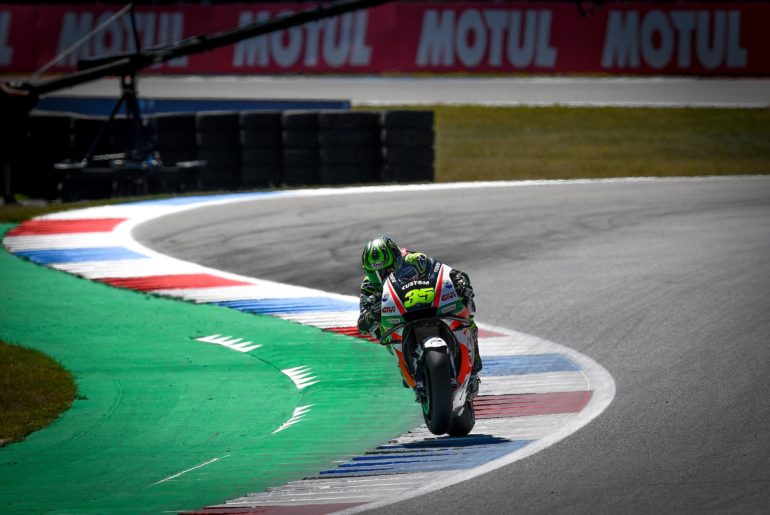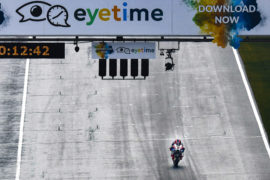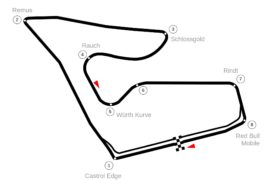How close is MotoGP right now? At the end of FP3 on Saturday morning, the top five bikes were separated by 0.062 seconds. The top three had just six thousandths of a second between them.
And the difference between Marc Márquez and Maverick Viñales, first and second in FP3? Just one thousandth of a second. If they were both lapping at the same time, it would have needed the special finish line camera to separate them.
It was pretty close behind the top five as well. There were sixteen riders within nine tenths of Márquez, gaps between them counted in hundredths of seconds, rather than thousandths of seconds.
Qualifying was much the same: the difference between pole and eleventh place on the grid was just half a second. If you made a mistake in two corners, costing you a tenth or so in each, you would have ended up starting from the third row, rather than the front row.
It was even worse for riders who hadn’t made it straight through to Q2. If Jack Miller had been a six hundredths faster in FP3, he could have ended up tenth instead of twelfth, and not have to go to Q1.
If he had been eight hundredths of a second faster in Q1, he would have been through to Q2, and not starting from sixteenth on the grid. But why pick on Miller? Taka Nakagami missed out on going to Q2 by a couple of hundredths, Tito Rabat and Hafizh Syahrin by seven hundredths.
Even Scott Redding, starting from seventeenth, was just four tenths off going to Q2. That is quite literally just the blink of an eye.
Seriously Serious
Why is everything so close? The bikes are much closer in performance, of course, a result of the changes to the technical regulations over the past seven seasons, but as Valentino Rossi explained, a lot of it was due to the professionalization of the riders, and of the teams.
“I think this is one of the biggest differences compared to fifteen years ago,” he said. “In the last period, we are always very close during the practice, but this weekend it looks more close. I think that compared to fifteen years ago, the level of professionalism of the sport is a lot. Now, the team but especially the rider try to work on all the small details, you try to learn, try to understand corner by corner, braking by braking.”
Things were simpler when Rossi first switched to Yamaha, but that was in part because the riders did not approach racing with the same utter dedication and work ethic. “Fifteen years ago, it was more romantic,” the Movistar Yamaha rider said.
“So you ride your bike, you have your feeling, but not like this. Now you have to work more. Maybe it’s a bit more boring… But I think that this is one of the biggest differences and I think it’s good for the championship.”
But it is also the nature of the racetrack. Assen is a riders’ track, a circuit where a rider can make up for the minor defects his motorcycle may have. Riding Assen is like threading a needle, maintaining your flow, your concentration, and if you can manage that, you can make up a lot of ground.
It’s easier when you can use a rider ahead of you as a target, and chase them down through braking and acceleration points, and make up time. That’s great if you can follow a fast rider, but not so great for the riders who get out ahead of a group, as Jorge Lorenzo found to his cost.
The factory Ducati rider took provisional pole with three minutes of qualifying left to go, and was on his way to another good time. But he was being followed by Andrea Iannone, who used him as a target to leapfrog ahead of him.
He would end up qualifying in tenth, as Johann Zarco towed another group around who would all end up ahead of Zarco, and ahead of Jorge Lorenzo.
Leading is Losing
“I think only Zarco was the only one, together with me, who was alone,” Lorenzo said after qualifying. “The rest of the riders were like a train, every rider with let’s say the perfect space – not too close to lose time in a certain part of the track and not too far not to take profit.”
“They were like the perfect meters to be as fast as possible, and everyone more or less the same meters apart. It was a strange situation, a strange qualifying. Everyone take profit of this little advantage that gave you from two to four tenths of extra speed. And the ones who were alone like Zarco and myself were eighth and tenth.”
Aleix Espargaro, who ended up seventh, had been a member of the group following Johann Zarco. The Aprilia rider felt that one major benefit of following other riders was that it kept him out of the wind, always a factor at Assen. “You know, it was super windy,” Espargaro said.
“It was clear that if you were behind somebody or in a group, it was a lot easier. To change the direction was a lot easier. Then Assen is a track where it’s not difficult to follow. So everybody knows this. Every qualifying is the same. I was pushing in the last lap.”
“Everybody was in front of me. I was behind Valentino. Everybody closed. It was like when the first one closed, the second closed, the third closed. Valentino and myself we closed the same. Then we all realized it was two minutes until the end. Everybody pushed and the times we did on the last lap were unbelievable. The top eight were all in the 1’33.0s. With the conditions we had today, that’s insane.”
Despite the fact that so many riders were following one another, there was only one man who came out on top. To borrow a phrase from English soccer star Gary Lineker, MotoGP qualifying is a sport in which twelve riders try to go as fast as possible on a motorcycle, and in the end, Marc Márquez gets pole.
It may only have been by a narrow margin, but this was his 47th pole in MotoGP, from 98 attempts. That is a strike rate of just under 48%. In other words, Marc Márquez starts from pole roughly every second race he competes in.
Faster than He Looks
The closeness of qualifying belies the advantage Márquez has at Assen.
The Repsol Honda rider’s pace in FP4 was withering: of the fourteen full laps he put in during the only practice session focused solely on race pace, fully half of them were quicker than Andrea Dovizioso’s best lap, who was third quickest in the session.
Andrea Iannone, second in FP4, had only a single lap anywhere near Márquez’ time, and that was set behind the Repsol Honda rider.
The race has all the hallmarks of a Márquez runaway, if he can lead from pole. Behind him, there are a big group of riders all pretty close in times, who could put up quite a fight. “For the race I think we have a good pace,” Andrea Dovizioso said.
“We are one of the fastest in the afternoon, for the race. But Marc is very consistent. I think the two Yamahas are in a good situation for the race and there are some others with good pace.”
Alex Rins, fifth on the grid, felt he could stay with that group chasing Márquez. “I think that the strategy for tomorrow is clear,” the Suzuki Ecstar rider told us.
“We need to do a good start. I think that tomorrow that the top guys like Lorenzo, Viñales, Márquez will break the group from the beginning, because we are a lot of riders in the same tenth. But I will try to go with them, because we have the rhythm, and I feel strong here.”
Breaking the Breakaway
The risk of being in a group was that it can split and fracture if someone makes a mistake, Cal Crutchlow conjectured.
“If someone makes a mistake and runs everyone out, or something like that, it can break it up quite fast, because this is a racetrack where if you lose somebody, it’s difficult to come back, it’s not somewhere where you can hunt someone down,” the LCR Honda rider told us.
“Dovi should be extremely confident, he had a fast pace in FP4 and he’s got a fast bike in 6th gear so he can pass into turn 6. And he’s riding well, but he was also fast at the other races and he didn’t finish them.”
That speed would off down the back straight, Crutchlow felt, where they could just make a gap into the very fast Ruskenhoek corner.
Crutchlow didn’t feel that Márquez’ advantage in practice would necessarily be transferred to the race. “I’m the same [in race pace] as everyone else,” the LCR Honda rider said.
“Marc has got a little bit better pace, two or three tenths, two of them in the last sector, one in the second sector it seems at the moment. But we’ve also seen it before this year when he’s got that but he also hasn’t won, like Qatar in the practice and qualifying, when it seemed it was stronger than anyone else but he never won the race.”
“So it’s potentially a big battle, I think if he goes away he can keep somewhere like Jerez, just one or two tenths but it’s enough. But you never know what could happen, if he makes a small mistake, there are seven riders behind him, it’s one of them. It’s going to be a close race for sure.”
A close qualifying had left Johann Zarco down in eighth, but after his initial frustration, the Monster Tech3 Yamaha rider learned to be phlegmatic about losing out. “When I finished the qualifying in that position I got like angry, because it’s not the best position to start the race,” Zarco said.
“But when you consider the gap, you cannot be disappointed. It means the job has been done and just the others are also pretty fast. For sure it looks like they followed me but I could not wait more and follow them.”
Satellite Reality
What was more frustrating for Zarco was that he felt like he was reaching the limits of what the Tech3 Yamaha can do. “From Friday to Saturday morning we have up and down about the feeling, about the setting,” Zarco said.
“I don’t know why, I wonder if maybe we are touching the best of what we can do, when we try to do a little bit better, we are going worse. So it’s complicated for the riding because you would like to have this constant feeling, to work also on yourself as a rider, but you cannot do it very well, so it’s a kind of experience.”
It is a familiar story. This, Zarco is learning, is what it means to be a satellite rider, and why being in a factory team can be so important.
Try as he and the gifted Tech3 team led by brilliant crew chief Guy Coulon may, they end up oscillating around the peak of his bike’s performance, with changes being sometimes a fraction better, sometimes a fraction worse, but never a big enough step forward to put him back in the game again.
It was frustrating, the Frenchman told us. “I have this frustration that when we are back on the way towards the good things, I say ‘OK, so now we do a few steps to get better.’ And since Mugello, but much more in Barcelona where we were more competitive than Mugello, the step we wanted to do does not give a better feeling.”
“So we are back to a worse feeling and then we must come back, and that brings frustration because I don’t know if it’s me who is going in the wrong direction or just maybe we touched the best we can do. I think that time will tell us those things, and I will stay cool because, as I say, eighth position can give this frustration but when you see the gap you cannot say that we are slow.”
Thinking is Bad for You
Zarco also acknowledged that stress had played a role in recent races, especially the stress of racing at his home round in Le Mans, where he crashed out, then again at Barcelona, which is partially a second French Grand Prix because the Spanish track is so close to the border. Assen was more relaxed, he said.
“Here in Assen, I feel quite good in my head, having less people around you. Here, in the evening, we are alone in the paddock and this gives back a good energy. So now it’s more that the competition is very high and this makes the situation difficult but now I enjoy even when it’s difficult.”
Stress was also playing a part in Dani Pedrosa’s struggles in Assen. With his future still not completely settled, and unable to talk about where he will be next year – either at the Petronas Yamaha team, or retired, even Pedrosa is not 100% yet – it made it hard to concentrate on riding the bike.
Having all these things on his mind was a distraction, Pedrosa acknowledged. “For sure it is a little bit playing, because when you think too much, you think too much. To ride this bike, you need not to think, more or less, so you need to have a free feeling and go,” Pedrosa explained.
“If you are overthinking – it can be this or it can be another aspect in your life – always affects a little bit your riding for sure.”
And that distraction was even more costly at a track like Assen, where every tenth his hard fought, and extremely valuable. “This afternoon I couldn’t really find the pace I need, and I could see unbelievably the lap times how close they were,” Pedrosa said.
“Especially in Q2: Lorenzo was first and then in one pass he was 10th and his lap time was already the fastest of the weekend. What I mean is, of course, if you are not feeling well and you miss one or two tenths, you already can be tenth, so when you don’t have the feeling and you are missing more, you are completely off.”
Photo: MotoGP
This article was originally published on MotoMatters, and is republished here on Asphalt & Rubber with permission by the author.




